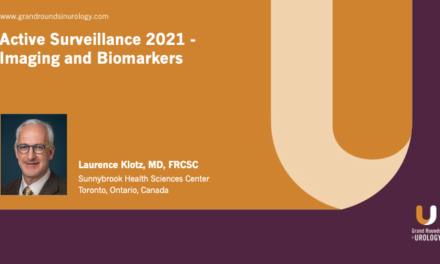Laurence Klotz, MD, presented “Active Surveillance 2021 – From Bench to Bedside” for the Grand Rounds in Urology audience in February 2021.
How to cite: Klotz, Laurence. “Active Surveillance 2021 – From Bench to Bedside” February 2021. Accessed Jul 2025. https://grandroundsinurology.com/active-surveillance-2021-from-bench-to-bedside/
Active Surveillance 2021 – From Bench to Bedside: Summary
In the first part of a Platinum Lecture trilogy on active surveillance, Laurence Klotz, MD, Professor of Surgery and holder of the Sunnybrook Chair of Prostate Cancer Research at the University of Toronto, discusses the history of active surveillance for prostate cancer as well as current guidance for its implementation. He first notes the major issues in early prostate cancer in the present day, including risk assessment prior to diagnosis, diagnostic evaluation of localized disease, and image-guided partial gland ablation therapy. Dr. Klotz then looks back to early papers suggesting that radical treatment may be unnecessary and ineffective in treating low-risk prostate cancers, remarking on their influence on himself and his colleagues’ 2002 feasibility study on watchful waiting. He reflects on how active surveillance has become widely accepted since that publication, and discusses what urologists have learned regarding patient selection, especially in terms of molecular genetics. Dr. Klotz then compares different studies of active surveillance, focusing on one with broad patient selection criteria and one with conservative selection criteria. The study with broader patient criteria found a raw prostate cancer-specific mortality of 1.5% and an actuarial mortality of 5% at 15 years, while the more conservative study found a prostate cancer-specific mortality of 0.5% at 15 years. Dr. Klotz notes that the 5% actuarial mortality in the first study was determined to be largely the result of the presence of pattern 4 disease at baseline. He also observes that there has been a convergence of selection criteria since those studies came out. Dr. Klotz concludes by discussing current active surveillance protocol, emphasizing the importance of doing a confirmatory biopsy.
For more on active surveillance for prostate cancer, check out our collection page for the 2020 International Prostate Cancer Update!
ABOUT THE AUTHOR
Laurence Klotz, MD, FRCSC, is a professor of surgery at the University of Toronto and the Sunnybrook Chair of Prostate Cancer Research. Dr. Klotz was the founding editor-in-chief of both the Canadian Journal of Urology and the Canadian Urology Association Journal (CUAJ), and he is now editor emeritus of the CUAJ. Dr. Klotz obtained his medical degree and completed his residency at the University of Toronto. He was also a uro-oncology fellow at Memorial Sloan Kettering Cancer Center in New York.
Dr. Klotz has 550 peer review publications and eight books. He coined the phrase “active surveillance” and successfully championed this approach for men with favorable-risk prostate cancer against substantial resistance. He was the associate editor of the Journal of Urology, responsible for prostate cancer, for eight years. Dr. Klotz received the Queen’s Jubilee Medal for outstanding public service, the University of Toronto's Lister Prize, the Society of Urologic Oncology’s SUO Medal, the American Urological Association’s Richard Williams Award, the University of Toronto's Lifetime Achievement Award, the Canadian Urological Association Lifetime Achievement Award, and the Harold Warwick Award from the Canadian Cancer Society for “outstanding contributions to cancer control.” In 2015 he was inducted as a Member of the Order of Canada, Canada’s highest civilian award.




